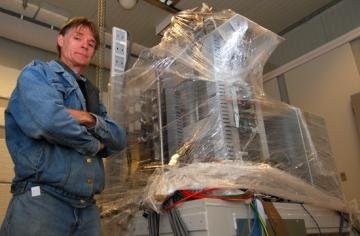
Dr Rodney Herring, professor of mechanical engineering and director of Advanced Microscopy Facility, University of Victoria, Canada, standing beside the STEHM (Image source: uvic.ca)
Singapore: The world's most powerful microscope, which resides in a specially constructed room at the University of Victoria, Canada, has now been fully assembled and tested, and has a lineup of scientists and businesses eager to use it.
The seven-tonne, 4.5-meter tall Scanning Transmission Electron Holography Microscope (STEHM), the first such microscope of its type in the world, came to the university in parts in 2012,. A team from Hitachi, which constructed the ultra high-resolution, ultra-stable instrument, spent one year assembling the STEHM in a carefully controlled lab in the basement of the Bob Wright Centre. The STEHM was specially built in Japan for UVic by Hitachi High Technologies Canada.
The wait was worth it, says Dr Rodney Herring, a professor of mechanical engineering and director of UVic's Advanced Microscopy Facility. With assembly complete, Herring and his team were able to finally test the microscope recently. They say the results are the start of a new era in scientific research.
"The STEHM will be used by local, regional, national and international scientists and engineers for a plethora of research projects relevant to the advancement of mankind," said Dr Herring. "This enables us to see the unseen world."
Dr Herring viewed gold atoms through the microscope at a resolution of 35 picometer. One picometer is a trillionth of a meter. This resolution is much better than the previous best image with 49- picometer resolution taken at the Lawrence Berkley National Laboratory in California, and is about 20 million times human sight. The STEHM allows researchers to see the atoms in a manner never before possible. It has full analytical capabilities that can determine the types and number or elements present, and high-resolution cameras for collecting data.
It will be used by researchers of many science and engineering disciplines for projects requiring knowledge of small atomic scale structures (nanoscience) and nanotechnology. Dr Vincenzo Grillo from the Istituto Nanoscienze Consiglio Nazionale Delle Ricerche in Modena will be the first visiting researcher later this month.
Local scientists and businesses are also eager to use it. Mr Ned Djilali, a UVic professor of mechanical engineering, is working with the National Research Council, Ballard Power Systems in Vancouver and Mercedes-Benz on fuel cell research. The STEHM "opens up entirely new possibilities" in fuel cell technology, says Mr Djilali.
Redlen Technologies, a local company that manufactures high resolution semiconductor radiation detectors that are used for such things as nuclear cardiology, CT scanning, baggage scanning and dirty bomb detection, has been waiting for the STEHM to open for the company's research and development.
The STEHM microscope is supported by $9.2 million in funding from the government of Canada through the Canadian Foundation for Innovation, the BC Knowledge Development Fund and UVic, as well as significant in-kind support from Hitachi.




